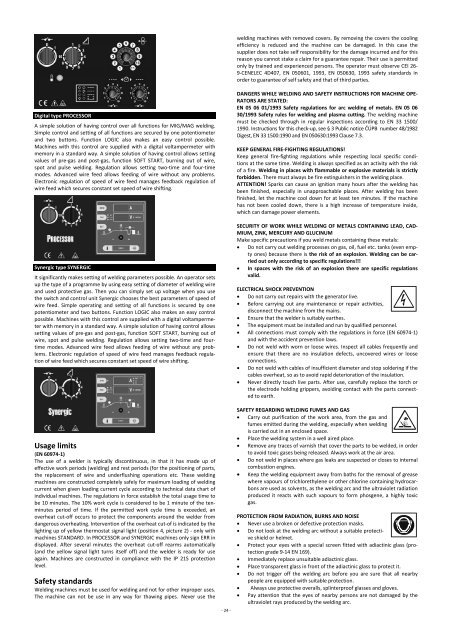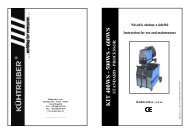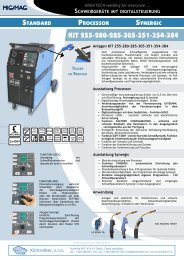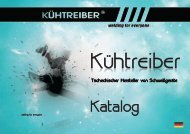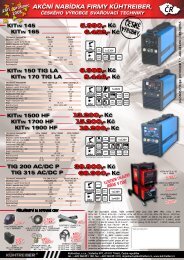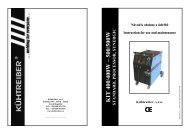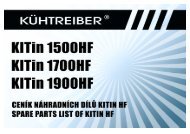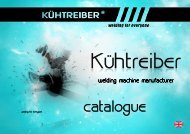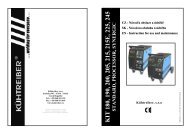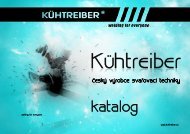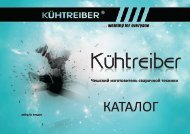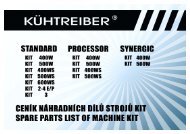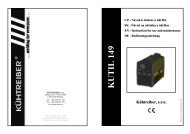Create successful ePaper yourself
Turn your PDF publications into a flip-book with our unique Google optimized e-Paper software.
welding machines with removed covers. By removing the covers the cooling<br />
efficiency is reduced and the machine can be damaged. In this case the<br />
supplier does not take self responsibility for the damage incurred and for this<br />
reason you cannot stake a claim for a guarantee repair. Their use is permitted<br />
only by trained and experienced persons. The operator must observe CEI 26‐<br />
9‐CENELEC 4D407, EN 050601, 1993, EN 050630, 1993 safety standards in<br />
order to guarantee of self safety and that of third parties.<br />
Digital type PROCESSOR<br />
A simple solution of having control over all functions for MIG/MAG welding.<br />
Simple control and setting of all functions are secured by one potentiometer<br />
and two buttons. Function LOGIC also makes an easy control possible.<br />
Machines with this control are supplied with a digital voltampermeter with<br />
memory in a standard way. A simple solution of having control allows setting<br />
values of pre‐gas and post‐gas, function SOFT START, burning out of wire,<br />
spot and pulse welding. Regulation allows setting two‐time and four‐time<br />
modes. Advanced wire feed allows feeding of wire without any problems.<br />
Electronic regulation of speed of wire feed manages feedback regulation of<br />
wire feed which secures constant set speed of wire shifting.<br />
Synergic type SYNERGIC<br />
It significantly makes setting of welding parameters possible. An operator sets<br />
up the type of a programme by using easy setting of diameter of welding wire<br />
and used protective gas. Then you can simply set up voltage when you use<br />
the switch and control unit Synergic chooses the best parameters of speed of<br />
wire feed. Simple operating and setting of all functions is secured by one<br />
potentiometer and two buttons. Function LOGIC also makes an easy control<br />
possible. Machines with this control are supplied with a digital voltampermeter<br />
with memory in a standard way. A simple solution of having control allows<br />
setting values of pre‐gas and post‐gas, function SOFT START, burning out of<br />
wire, spot and pulse welding. Regulation allows setting two‐time and fourtime<br />
modes. Advanced wire feed allows feeding of wire without any problems.<br />
Electronic regulation of speed of wire feed manages feedback regulation<br />
of wire feed which secures constant set speed of wire shifting.<br />
Usage limits<br />
(EN 60974‐1)<br />
The use of a welder is typically discontinuous, in that it has made up of<br />
effective work periods (welding) and rest periods (for the positioning of parts,<br />
the replacement of wire and underflushing operations etc. These welding<br />
machines are constructed completely safely for maximum loading of welding<br />
current when given loading current cycle according to technical data chart of<br />
individual machines. The regulations in force establish the total usage time to<br />
be 10 minutes. The 10% work cycle is considered to be 1 minute of the tenminutes<br />
period of time. If the permitted work cycle time is exceeded, an<br />
overheat cut‐off occurs to protect the components around the welder from<br />
dangerous overheating. Intervention of the overheat cut‐of is indicated by the<br />
lighting up of yellow thermostat signal light (position 4, picture 2) ‐ only with<br />
machines STANDARD. In PROCESSOR and SYNERGIC machines only sign ERR in<br />
displayed. After several minutes the overheat cut‐off rearms automatically<br />
(and the yellow signal light turns itself off) and the welder is ready for use<br />
again. Machines are constructed in compliance with the IP 21S protection<br />
level.<br />
Safety standards<br />
Welding machines must be used for welding and not for other improper uses.<br />
The machine can not be use in any way for thawing pipes. Never use the<br />
‐ 24 ‐<br />
DANGERS WHILE WELDING AND SAFETY INSTRUCTIONS FOR MACHINE OPE‐<br />
RATORS ARE STATED:<br />
EN 05 06 01/1993 Safety regulations for arc welding of metals. EN 05 06<br />
30/1993 Safety rules for welding and plasma cutting. The welding machine<br />
must be checked through in regular inspections according to EN 33 1500/<br />
1990. Instructions for this check‐up, see § 3 Public notice ČÚPB number 48/1982<br />
Digest, EN 33 1500:1990 and EN 050630:1993 Clause 7.3.<br />
KEEP GENERAL FIRE‐FIGHTING REGULATIONS!<br />
Keep general fire‐fighting regulations while respecting local specific conditions<br />
at the same time. Welding is always specified as an activity with the risk<br />
of a fire. Welding in places with flammable or explosive materials is strictly<br />
forbidden. There must always be fire extinguishers in the welding place.<br />
ATTENTION! Sparks can cause an ignition many hours after the welding has<br />
been finished, especially in unapproachable places. After welding has been<br />
finished, let the machine cool down for at least ten minutes. If the machine<br />
has not been cooled down, there is a high increase of temperature inside,<br />
which can damage power elements.<br />
SECURITY OF WORK WHILE WELDING OF METALS CONTAINING LEAD, CAD‐<br />
MIUM, ZINK, MERCURY AND GLUCINUM<br />
Make specific precautions if you weld metals containing these metals:<br />
Do not carry out welding processes on gas, oil, fuel etc. tanks (even empty<br />
ones) because there is the risk of an explosion. Welding can be carried<br />
out only according to specific regulations!!!<br />
In spaces with the risk of an explosion there are specific regulations<br />
valid.<br />
ELECTRICAL SHOCK PREVENTION<br />
Do not carry out repairs with the generator live.<br />
Before carrying out any maintenance or repair activities,<br />
disconnect the machine from the mains.<br />
Ensure that the welder is suitably earthes.<br />
The equipment must be installed and run by qualified personnel.<br />
All connections must comply with the regulations in force (EN 60974‐1)<br />
and with the accident prevention laws.<br />
Do not weld with worn or loose wires. Inspect all cables frequently and<br />
ensure that there are no insulation defects, uncovered wires or loose<br />
connections.<br />
Do not weld with cables of insufficient diameter and stop soldering if the<br />
cables overheat, so as to avoid rapid deterioration of the insulation.<br />
Never directly touch live parts. After use, carefully replace the torch or<br />
the electrode holding grippers, avoiding contact with the parts connected<br />
to earth.<br />
SAFETY REGARDING WELDING FUMES AND GAS<br />
Carry out purification of the work area, from the gas and<br />
fumes emitted during the welding, especially when welding<br />
is carried out in an enclosed space.<br />
Place the welding system in a well aired place.<br />
Remove any traces of varnish that cover the parts to be welded, in order<br />
to avoid toxic gases being released. Always work at the air area.<br />
Do not weld in places where gas leaks are suspected or closes to internal<br />
combustion engines.<br />
Keep the welding equipment away from baths for the removal of grease<br />
where vapours of trichlorethylene or other chlorine containing hydrocarbons<br />
are used as solvents, as the welding arc and the ultraviolet radiation<br />
produced it reacts with such vapours to form phosgene, a highly toxic<br />
gas.<br />
PROTECTION FROM RADIATION, BURNS AND NOISE<br />
Never use a broken or defective protection masks.<br />
Do not look at the welding arc without a suitable protective<br />
shield or helmet.<br />
Protect your eyes with a special screen fitted with adiactinic glass (protection<br />
grade 9‐14 EN 169).<br />
Immediately replace unsuitable adiactinic glass.<br />
Place transparent glass in front of the adiactinic glass to protect it.<br />
Do not trigger off the welding arc before you are sure that all nearby<br />
people are equipped with suitable protection.<br />
Always use protective overalls, splinterproof glasses and gloves.<br />
Pay attention that the eyes of nearby persons are not damaged by the<br />
ultraviolet rays produced by the welding arc.


